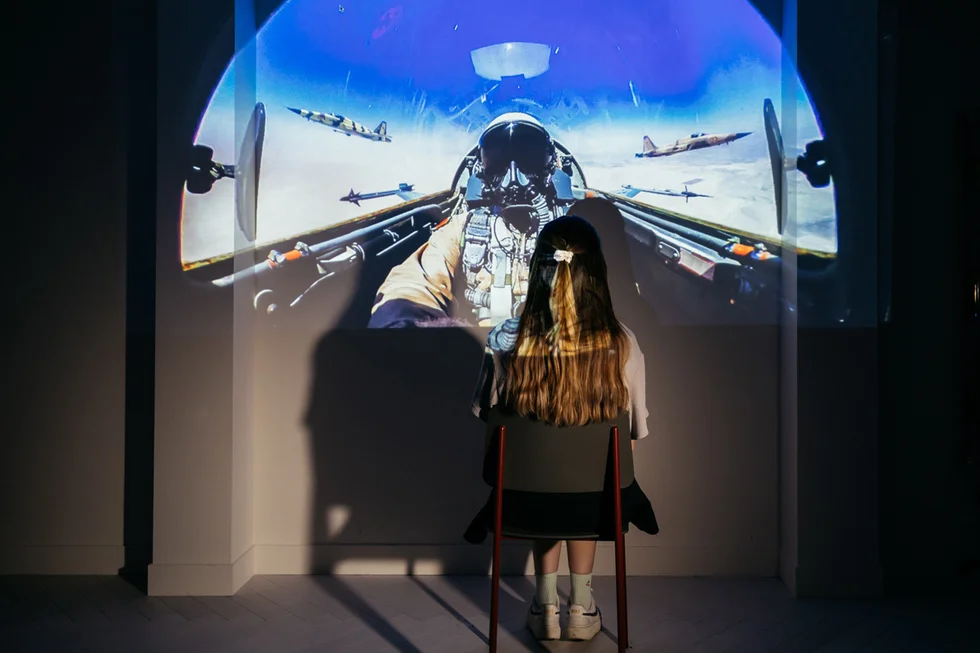Top Gun: An anti-ageist movie? Not exactly…
Oct 06, 2022
6 mins


Thirty-six years have passed since the first Top Gun, and “Maverick” (Tom Cruise), the hot shot pilot, is back. Called into service once more, this time to train young pilots, his age makes him the butt of jokes. However, in the military, just as in private businesses, having an “elder” on board helps us take a step back and make plans grounded in experience and, perhaps, wisdom….Well, that’s what our Lab expert Laetitia Vitaud learned from watching the movie.
Whether or not you’re one of the millions who watched Top Gun: Maverick in 2022, you would have had to be living under a rock to miss all the hype and hundreds of articles analyzing its incredible international success. It’s not just viewers from Tom Cruise’s generation (remembering the first Top Gun from 1986) who loved the film. Every generation has headed to the big screen in droves, just like in the good ol’ days of summer blockbusters. Much like Stranger Things on Netflix, Maverick plays on our nostalgia for the 1980s with the styles, the music, and the representation of a glorious, powerful United States. (To be fair, if current politics are anything to go by, the Cold War is having its own sequel of sorts, too.)
A maverick is a solitary individual with an independent spirit and mind. Top Gun was first made as a Western in 1955, so it’s no accident that Tom Cruise, both in 1986 and today, channels the myth of the great American Cowboy, vanquishing adversity with dollops of heroic virility. But in round two, the lone ranger is forced to become part of a team. As an instructor for Top Gun, the Navy’s fighter pilot training program, Maverick has to train, then lead a team of fine young pilots on an almost impossible, perilous mission. So, in the spirit of work experience, it should come as no surprise that there are some great HR lessons to be taken from the film.
“Assholes” will put your team in danger
Top Gun extols the virtues of the elite talents who rise to the heights of naval aviation (the “best of the best”), but Maverick quickly understands that he needs to turn this group of elite individuals into a team in order for their mission impossible (saving the world from enriched uranium in an unnamed, hostile nation) to be a success. At first, the pilots give him the cold shoulder. Tensions run high: one of the pilots, Rooster, is mad at Maverick for putting the brakes on his career years back; another, Hangman, isn’t much of a team player. But once they come to see Maverick’s unique genius, the pilots finally take his first lesson on board: In order to succeed, you have to put your ego aside, create a seamless professional relationship with your teammates, and perfectly coordinate your actions in order to achieve the desired goal. To foster team spirit, Maverick plans a football match on the beach. He knows that how they get along socially will make or break the mission.
Had Maverick read The No Asshole Rule? A famous Robert Sutton book explaining that, as brilliant as they may be, “assholes” (harassers, narcissists, selfish jerks…) always get in the way of a team’s success. The movie seems to criticize the “toxic” behaviors of individuals with overblown egos and gives a clear messager: To create a strong group culture—which is more important than any individual—emotional security is key. Professional ”elders” can be young—at heart
Just as Maverick is almost 60 years old—with the same fire and passion of his youth— he had to stall his military career in order to keep flying, mirroring how often companies base their HR policies on a linear view of careers and age. We like to recruit and train employees when they’re young and offer careers in which progression means more managerial responsibilities. Progressing means moving up the ranks of the hierarchy and moving away from the job you were first recruited for. However, more and more workers begrudge taking on more managerial responsibilities.
Linear careers are becoming less the norm. Some people want to move laterally and try a different role at the same level. As 50 and 60 year olds are working for longer than the previous generations, they want to continue to be trained and to train others, or even work part-time towards the end of their career. Why up and leave to suddenly retire when you still have so much energy to give? Organizations need experienced workers
Maverick’s expertise is recognized, even by his critics. They need him to train the 12 pilots who’ll fly the mission and to fly, himself. In the middle of the mission, he has to eject and finds himself fighting on the ground for his survival. His buddy, Rooster, decides to go and fight with him. Deep behind enemy lines, the two partners find a way to escape: an old, reconditioned F-14 Tomcat (the plane used in the first Top Gun movie). If not for Maverick’s knowledge, the escape wouldn’t have been possible. The military isn’t alone in using old technology. In fact, in most large organizations, several generations of technology are layered together. Banks, for example, look to hire IT experts who know how to program Cobol (one of the first computer languages in history), but it is not often taught anymore. It can be so hard to find workers with those specific skills that recruiters sometimes have to try to lure people out of retirement to help. We live under the illusion that new technology replaces the old. But that’s not always true: more often than not, the technologies are layered together; existing in symbiosis, so several generations of skills are required. Now onto the movie’s inadvertent lessons…
Reverse ageism
On the surface the movie is anti-ageist. But on the flip side, Maverick shows awful reverse ageism. The whole movie is designed to “prove” his virility and youth. He’s shown as faster and stronger than all the other characters. He rides a motorbike, just like he did when he was 20. He climbs out of his lover’s window like a teenager. And several characters only exist to highlight his amazing vitality. His colleague in the hypersonic plane test says he’s “the fastest man on Earth” while his lover, tells him not to break her heart yet another time. So he’s the best pilot, the best lover, and also the best trainer and manager. Seriously?! Do we really need to be the best at everything, constantly proving we do it better than anyone younger? Does wisdom not come with age? I wanted to scream, “Stand down, Tom!” at the screen. Why are we so insecure about the passing of time?
This movie was made to glorify Tom Cruise (through his character) and demonstrates the actor/producer’s extreme desire for control. You can sense that he’s a control freak and has checked every camera movement to avoid showing a single wrinkle or glimpse of a sagging 60-year-old pec. It’s as if the slightest sign of aging is totally unacceptable—the only skills that count are those acquired in youth. It’s a direct contradiction of the movie’s overt message and reveals the powerful reverse ageism within our society. We act as if we value age but in reality, we detest it. The only possible solution is to deny aging and hide it like Maverick/Cruise. Admiral Kazanski (Val Kilmer), isn’t afraid to show his age, but he’s seriously ill and dies halfway through the movie. Who wants to be like him?
Do you need to be doing the same things as a 20-year-old when you’re 60 to be seen as worthy of interest? Reverse ageism in our society strikes fear into millions of professionals’ hearts as they worry over being put out to pasture or made fun of. The employment rate for the over 55s hovers under 40% in the US, lower than any other age group (in Sweden you’re looking at 80%). Just like in the movies, there’s a cognitive dissonance between what we say about valuing experience and the reality of a working environment in which you have to “appear young” to survive.
Boy’s club culture reigns
Top Gun 2 has the same boys’ club feel to it as Top Gun 1. What the movie reveals is that beyond a few cosmetic changes, job diversity, prestige and power at work haven’t changed much in the last 30 years.
There’s nothing like a Hollywood movie to spur a recruitment drive
When the first Top Gun movie was released in 1986, the US Marines set up information stands (for recruitment) outside of certain movie theatres. 500% more soldiers signed up that year. Hollywood is a great ally for the US military. That’s why the US Defense Minister works with the movie industry, for example, by loaning their most precious ‘playthings.’
This collaboration is so important that it’s said the DOD is an anonymous co-producer for thousands of movies and that Hollywood is its propaganda machine. For the military, it’s the best way of ensuring a regular influx of candidates. By showcasing the camaraderie, talent, and courage of individuals working for a clear righteous cause (saving the nation or the world), the movie is a recruitment tool. Top Gun: Maverick mentions how the technical advances of other nations are now greater than the US (especially China), but shows that human and moral superiority still sit firmly with our nation. “If you want to work with the best, join us!“
The (inadvertent) recruitment lesson is two-fold. The first thing is that many of us feel the need to belong to something greater than ourselves, to be part of a team where we feel emotionally safe, and to serve others. The second is that as a recruitment tool, nothing makes us want something more than a timeless inspirational story.
Photo: Welcome to the Jungle
Follow Welcome to the Jungle on Facebook, LinkedIn, and Instagram, and subscribe to our newsletter to get our latest articles every day!

More inspiration: Laetitia Vitaud
Future of work author and speaker

Age does matter, at work and in the White House
What we've learned from the 2024 presidential elections about aging at work.
Sep 09, 2024

Can companies avoid a brain drain as retirements surge?
Bye bye, Baby Boomers. Hello, knowledge exodus?
Jun 12, 2024

Workplace anxiety: Navigating the future of work in an anxious world
Anxiety has taken center stage in our modern world. How is it shaping the future of work? And most of all, what can we do about it?
May 20, 2024

Why recruiters should hire more ex-freelancers
While freelance and salaried work can seem worlds apart, they may have more in common than you think.
May 02, 2024

How women over 50 are reinventing their careers and the future of work
Women in their 20s struggle to be taken seriously, while middle-aged women battle discrimination... So how are women over 50 reinventing the wheel?
Apr 02, 2024
The newsletter that does the job
Want to keep up with the latest articles? Twice a week you can receive stories, jobs, and tips in your inbox.

Looking for your next job?
Over 200,000 people have found a job with Welcome to the Jungle.
Explore jobs